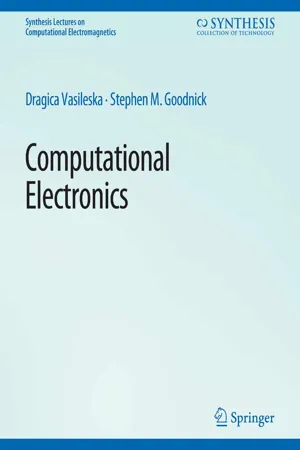
- English
- PDF
- Available on iOS & Android
eBook - PDF
Computational Electronics
About this book
Computational Electronics is devoted to state of the art numerical techniques and physical models used in the simulation of semiconductor devices from a semi-classical perspective. Computational electronics, as a part of the general Technology Computer Aided Design (TCAD) field, has become increasingly important as the cost of semiconductor manufacturing has grown exponentially, with a concurrent need to reduce the time from design to manufacture. The motivation for this volume is the need within the modeling and simulation community for a comprehensive text which spans basic drift-diffusion modeling, through energy balance and hydrodynamic models, and finally particle based simulation. One unique feature of this book is a specific focus on numerical examples, particularly the use of commercially available software in the TCAD community. The concept for this book originated from a first year graduate course on computational electronics, taught now for several years, in the Electrical Engineering Department at Arizona State University. Numerous exercises and projects were derived from this course and have been included. The prerequisite knowledge is a fundamental understanding of basic semiconductor physics, the physical models for various device technologies such as pndiodes, bipolar junction transistors, and field effect transistors.
Frequently asked questions
Yes, you can cancel anytime from the Subscription tab in your account settings on the Perlego website. Your subscription will stay active until the end of your current billing period. Learn how to cancel your subscription.
At the moment all of our mobile-responsive ePub books are available to download via the app. Most of our PDFs are also available to download and we're working on making the final remaining ones downloadable now. Learn more here.
Perlego offers two plans: Essential and Complete
- Essential is ideal for learners and professionals who enjoy exploring a wide range of subjects. Access the Essential Library with 800,000+ trusted titles and best-sellers across business, personal growth, and the humanities. Includes unlimited reading time and Standard Read Aloud voice.
- Complete: Perfect for advanced learners and researchers needing full, unrestricted access. Unlock 1.4M+ books across hundreds of subjects, including academic and specialized titles. The Complete Plan also includes advanced features like Premium Read Aloud and Research Assistant.
We are an online textbook subscription service, where you can get access to an entire online library for less than the price of a single book per month. With over 1 million books across 1000+ topics, we’ve got you covered! Learn more here.
Look out for the read-aloud symbol on your next book to see if you can listen to it. The read-aloud tool reads text aloud for you, highlighting the text as it is being read. You can pause it, speed it up and slow it down. Learn more here.
Yes! You can use the Perlego app on both iOS or Android devices to read anytime, anywhere — even offline. Perfect for commutes or when you’re on the go.
Please note we cannot support devices running on iOS 13 and Android 7 or earlier. Learn more about using the app.
Please note we cannot support devices running on iOS 13 and Android 7 or earlier. Learn more about using the app.
Yes, you can access Computational Electronics by Dragica Vasileska,Stephen M. Goodnick,Stephen Goodnick in PDF and/or ePUB format, as well as other popular books in Technology & Engineering & Electrical Engineering & Telecommunications. We have over one million books available in our catalogue for you to explore.
Information
Table of contents
- Cover
- Copyright Page
- Title Page
- Contents
- Introduction to Computational Electronics
- Semiconductor Fundamentals
- The Drift–Diffusion Equations and TheirNumerical Solution
- Hydrodynamic Model
- Use of Commercially Available Device Simulators
- Particle-Based Device Simulation Methods
- Appendix A
- Appendix B
- References